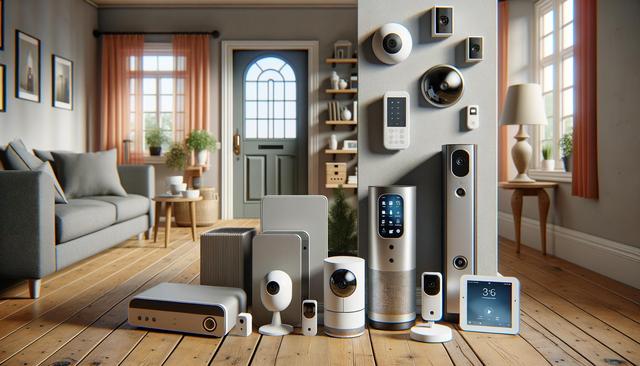Understanding the Essentials of Home Security Systems
When it comes to home security systems, understanding the basics is crucial. A comprehensive system typically comprises surveillance cameras, motion detectors, alarms, and smart locks. Each component plays a vital role in ensuring your property’s safety. Surveillance cameras, for instance, are essential for monitoring activity and deterring potential intruders. They come in various types, including wireless and wired options, which can be strategically installed to cover vulnerable areas of your home.
Motion detectors enhance your security system by alerting you to any unusual movements. They can be placed indoors or outdoors, providing an added layer of protection. Alarms, on the other hand, are designed to scare off intruders and notify you or the authorities of a breach. Lastly, smart locks offer convenience and security by allowing you to control access to your home remotely.
Choosing the right components for your home security system is determined by several factors, including your budget, property size, and specific security needs. With a clear understanding of these essentials, you can make informed decisions to enhance your home’s safety effectively.
Advantages of Installing Surveillance Cameras
Surveillance cameras are a cornerstone of modern home security systems. They not only provide evidence in the event of a security breach but also act as a deterrent to potential criminals. By installing cameras in strategic locations, you can monitor both the interior and exterior of your home, ensuring comprehensive coverage.
When selecting a surveillance camera, consider factors such as resolution, field of view, and connectivity options. Wireless cameras offer flexibility in installation, while wired options may provide a more stable connection. It’s important to choose a camera with a reliable power source to prevent disruptions in monitoring.
Installing surveillance cameras can also provide peace of mind when you’re away from home. With remote access features, you can view live feeds and recorded footage from your smartphone or computer, keeping you informed of any suspicious activity. Overall, surveillance cameras are an invaluable tool in maintaining your home’s security.
Choosing the Right Home Security System for Your Needs
Selecting the right home security system involves considering several key factors. First, assess your property’s vulnerabilities and identify areas that require enhanced protection. This assessment will guide you in choosing the appropriate components, such as cameras, alarms, and motion detectors.
Budget is another important consideration. Home security systems come in a range of prices, so it’s essential to find a solution that fits your financial constraints while meeting your security needs. Additionally, consider the ease of installation and whether you prefer a DIY approach or professional installation.
- Evaluate the system’s scalability if you plan to expand coverage in the future.
- Look for systems with reliable customer support and warranties.
- Consider the integration capabilities with smart home devices for added convenience.
By carefully evaluating these factors, you can select a home security system that provides exceptional quality and peace of mind.
Installation Tips for Maximizing Security
Proper installation is crucial to maximizing the effectiveness of your home security system. Begin by selecting the optimal locations for each component, ensuring a clear field of view for cameras and strategic placement for motion detectors. It’s essential to cover all entry points and high-traffic areas to capture any potential threats.
When installing cameras, consider the height and angle to avoid blind spots. Connecting cameras to a reliable power source is also crucial for uninterrupted operation. For wireless cameras, ensure a strong Wi-Fi signal to maintain a steady connection.
- Regularly test your system to ensure all components are functioning correctly.
- Keep the system’s software up to date to benefit from the latest security features.
- Secure your network to prevent unauthorized access to your surveillance footage.
Following these installation tips will help ensure your home security system operates efficiently, providing the protection you need.
The Role of Technology in Enhancing Home Security
Advancements in technology have significantly enhanced the capabilities of home security systems. Smart home integration allows you to control and monitor your security components from a single app, providing convenience and peace of mind. Features such as remote access, real-time notifications, and video recordings keep you informed of any security breaches.
Artificial intelligence and machine learning are also being integrated into security systems to improve threat detection and response. These technologies can analyze patterns and identify unusual activities, alerting you to potential risks more accurately.
The growing popularity of cloud storage offers a secure way to store surveillance footage, ensuring it’s accessible even if the physical system is compromised. Additionally, voice control features allow for hands-free management of your security system, enhancing user experience.
By embracing technological advancements, you can create a home security system that is both effective and user-friendly, ensuring the safety of your property and loved ones.
Conclusion
In conclusion, investing in a top-rated value home security system is a wise decision to protect your property. By understanding the essential components and installation practices, you can create a robust security setup tailored to your needs. Surveillance cameras, motion detectors, and smart locks work together to deter crime and provide peace of mind. As technology continues to evolve, home security systems are becoming more advanced and accessible, offering exceptional quality and convenience. With the right system in place, you can rest assured knowing your home is secure.
